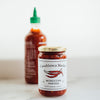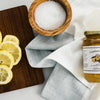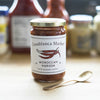Preserved Lemons 101: What are They?
- by Katia Essyad
- 1 comment
Most home cooks are aware of the power of lemons: They clean, they cook, they put the baby down for a nap. Okay, that last bit isn’t true, but lemons are an amazing fruit that really does have tremendous cleaning power and are practically magic when it comes to cooking. If a dressing, soup or sauce is too bland or too salty, a hefty squeeze of lemon juice can balance it out. Its juice can tenderize meats in marinades, keep roasted fish moist and delicious, bring boring veggies back to life and provide a layer of intrigue and freshness to sweets and desserts.
That’s why we love preserved lemons — they’re extra-powerful lemons, like lemons wearing superhero capes! They’ve been long-standing staple condiments in North African and South Asian cuisines, and over the past few years have slowly been gaining steam as an ingredient in the United States.
So what exactly are preserved lemons, and where and how did they originate?
First, let’s take a look at what they are:
Essentially, preserved lemons (sometimes referred to as “country lemons” or “leems”) are a type of pickle. Generally, fresh lemons are packed into a glass jar diced, quartered, halved or whole. Then, a brine made from water, lemon juice and salt (sometimes seasoned with spices) is poured on top to cover the lemons. This mixture ferments at room temperature for weeks (sometimes even months) before it is ready to go. The process of fermentation transforms the lemon into an evolved version of itself: The acidity and bitterness mellows, while the telltale flavor and sweetness remains. The brine makes it salty and excellent for adding depth to dishes.
Once the preserved lemons are finished fermenting, they will keep almost indefinitely in the refrigerator. A little goes a long way: The pulp can be rinsed and then used to enhance seafood, soups and salad dressings. The peel, which is still a bit tart and very lemony, can be added to tagines, stews, braises, vegetables, salads, pastas — really anywhere you want a big, bold hit of lemon flavor!
Our preserved lemons are extra special because we use beldi lemons (“beldi” means “traditional” — for us, it means things that are made with love and care), an indigenous lemon grown in Taroudant, southern Morocco, used to make authentic preserved lemons.
The origins of preserved lemons:
Much like other methods of pickling and preserving, preserved lemons originated as a method of keeping lemons usable after they weren’t in season anymore or if they were imported far from where they were grown. Lemons have been prized by many cultures for millennia both for their decorative and culinary purposes, and though there isn’t a lot of documentation of preserved lemons, it stands to reason that savvy home cooks have been fermenting and preserving them for hundreds of years. Recipes for preserved lemons begin appearing in European cookbooks in the early- to mid-1800s.

These days, chefs and home cooks across the globe know that preserved lemons are an indispensable ingredient for numerous dishes, with their beautifully mellowed lemon flavor and lovely texture. Now it’s your turn to incorporate a jar into your lineup of pantry staples! Just remember: As with all pantry staples, quality is key. That’s why we use only the absolute best lemons to create Casablanca Market Preserved Lemons!
Sign up for our newsletter to stay current with the latest, greatest and tastiest. Follow Casablanca Market on Instagram, Facebook and Twitter. For cooking ideas, don’t miss our YouTube channel and Pinterest page!






I purchased your preserved lemons as recommended by the book “Save YourLife With the Phenomenal Lemon and Lime”. They taste wonderful, even by themselves after dinner. I know they are quite beneficial to our health, as well.